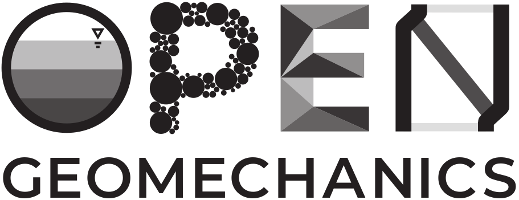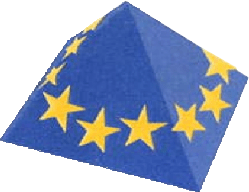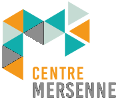Submission
To submit your article to Open Geomechanics please click here and create an account.
We only accept papers as LaTeX documents for ease of formatting and due to our hosting platform. If you use the online LaTeX editor Overleaf, you can find our template here, please make a copy of this template and edit as appropriate. An offline version of the template will be available soon.
Accepted papers will be distributed with a Creative Commons CC-BY-NC-SA license, and LaTeX sources are made available to readers, to facilitate accessibility.
We are a Diamond Open Access journal, so there is no article processing charge, and no charge to read the articles.
Author's rights are retained by authors.
Style guide
There is an Open Geomechanics latex style.
Paper layout
There are no minimum or maximum page or figure numbers for publication in Open Geomechanics. The abstract should fit on the first page.
Image formats
We prefer vector graphics, such as the pdf and eps file formats, but will take anything that compiles into the LaTeX source code and is legible, clear and informative.
Cover image for use on website
Please select one of your figures, or an additional figure, to be used as a cover image on the website as a graphical abstract. The number of browsers who read your paper is likely to be proportional to the quality of this image.
Editorial Policy
(Updated 23 January 2020)
We have based our editorial practices on the Committee on Publication Ethics Core Practices and the relevant ICJME Recommendations, and significant portions of the text below contains verbatim quotes from these guides without particular attribution.
Allegations of misconduct
When scientific misconduct is alleged, or concerns are otherwise raised about the conduct or integrity of work described in submitted or published papers, the editor will initiate appropriate procedures detailed by the Committee on Publication Ethics, consider informing the institutions and funders, and may choose to publish an expression of concern pending the outcomes of those procedures. If the procedures involve an investigation at the authors’ institution, the editor will seek to discover the outcome of that investigation; notify readers of the outcome if appropriate; and if the investigation proves scientific misconduct, publish a retraction of the article. There may be circumstances in which no misconduct is proven, but an exchange of letters to the editor could be published to highlight matters of debate to readers.
Expressions of concern and retractions will be prominently labelled, will appear on the main Open Geomechanics page and be properly indexed, and include in their heading the title of the original article. Online, the retraction and original article will be linked in both directions and the retracted article will be clearly labelled as retracted in all its forms (abstract, full text, PDF). Ideally, the authors of the retraction should be the same as those of the article, but if they are unwilling or unable the editor may under certain circumstances accept retractions by other responsible persons, or the editor may be the sole author of the retraction or expression of concern. The text of the retraction will explain why the article is being retracted and include a complete citation reference to that article.
Retracted articles will remain in the public domain and be clearly labelled as retracted.
The validity of previous work by the author of a fraudulent paper cannot be assumed. Editors may ask the author’s institution to assure them of the validity of other work published in their journals, or they may retract it. If this is not done, editors may choose to publish an announcement expressing concern that the validity of previously published work is uncertain.
Authorship and contribution
Open Geomechanics requires that authorship be based on the following 4 criteria:
-
Substantial contributions to the conception or de- sign of the work; or the acquisition, analysis, or interpretation of data for the work; AND
-
Drafting the work or revising it critically for important intellectual content; AND
-
Final approval of the version to be published; AND
-
Agreement to be accountable for all aspects of the work in ensuring that questions related to the accuracy or integrity of any part of the work are appropriately investigated and resolved.
In addition to being accountable for the parts of the work he or she has done, an author should be able to identify which co-authors are responsible for specific other parts of the work. In addition, authors should have confidence in the integrity of the contributions of their co-authors.
Complaints and appeals
Complaints and appeals should in the first instance be directed to the relevant editor who handled the submission. The editor will consider the complaint or appeal and form a decision as to whether or not a submission will be reconsidered.
If a suitable resolution cannot be found after this process, or you have issues that cannot be resolved by the editor in question, you should direct your complaints to the board of editors collectively, who can be contacted at editor@opengeomechanics.org.
Conflicts of interest/competing interests
All participants in the peer-review and publication process — not only authors but also peer reviewers, editors, and editorial board members of journals — must consider and disclose their relationships and activities when fulfilling their roles in the process of article review and publication.
Data and reproducibility
Open Geomechanics strongly encourages all authors to share the data used in their publications both during the review process and after publication. Investigators have a duty to maintain the primary data and analytic procedures underpinning any published results for at least 10 years. We encourage preservation of this data in a public repository to ensure longer-term availability.
Intellectual property
Work published in Open Geomechanics remains the intellectual property of the authors. Accepted papers will be distributed with a Creative Commons CC-BY-NC-SA license, and LaTeX sources are made available to readers, to facilitate accessibility.
Journal management
The journal is administered by a team of editors. No formal policy exists to mandate the number or make-up of the editorial team, the duration of their tenure or the circumstances through which they should be replaced. However, it is a guiding principle of Open Geomechanics that to improve academic culture, editors should seek to engage a broad and diverse array of authors, reviewers, editorial staff, editorial board members, and readers.
Peer review processes
Open Geomechanics takes reviewing seriously. We use a double blind review system, where the author information is hidden from reviewers, and vice versa (see this paper for an interesting findings regarding review quality with and without double blinding). In Open Geomechanics, this anonymity exists only until a paper is accepted. If a manuscript is accepted for publication, edited versions of the reviews and responses will be published along with the article. After acceptance, reviewers have the right to maintain their anonymity, but their reviews will be published whether they recommend the work for publication or not.
Manuscripts submitted to journals are privileged communications that are authors’ private, confidential property, and authors may be harmed by premature disclosure of any or all of a manuscript’s details.
Reviewers and editors therefore should keep manuscripts and the information they contain strictly confidential. Reviewers and editors must not publicly discuss authors’ work and must not appropriate authors’ ideas before the manuscript is published. Reviewers and editors must not retain the manuscript for their personal use and should destroy copies of manuscripts after submitting their reviews.
Reviewers who seek assistance from a trainee or colleague in the performance of a review should acknowledge these individuals’ contributions in the written comments submitted to the editor. These individuals must maintain the confidentiality of the manuscript as outlined above.
Reviewers are expected to respond promptly to requests to review and to submit reviews within the time agreed. Reviewers’ comments should be constructive, honest, and polite.
Reviewers should declare their relationships and activities that might bias their evaluation of a manuscript and recuse themselves from the peer-review process if a conflict exists.
Publishing schedule
Open Geomechanics is an online-only journal, as such accepted papers appear on the website as soon as they are accepted and finalised, and are not grouped into issues or volumes.
Papers are grouped by year of publication for convenience.



